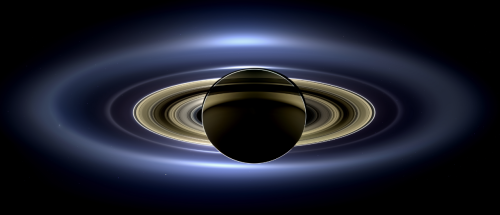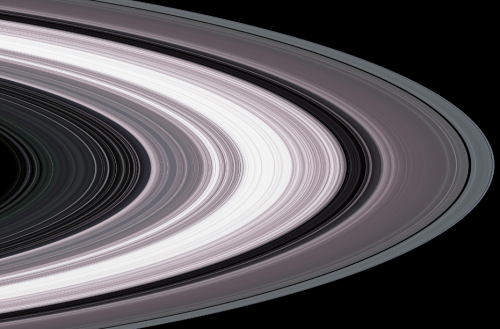Lord of the RingsSaturn is one of the most recognisable planets because of the magnificent rings tha
Lord of the RingsSaturn is one of the most recognisable planets because of the magnificent rings that sweep around it, gleaming bright in the sunlight. The rings are made up of billions of icy particles, ranging in size from dust-size grains to a particles the size of houses. The particles are 99.9% pure water-ice with a tiny rocky component, and this ice is the reason they’re so brilliant - the sun just reflects right off them. They rings actually highly structured, with a bunch of separate rings orbiting concentrically, with some gaps in between. The main rings are imaginatively but practically called C, B, and A, with fainter rings on the inside and outside of these three. Two of Saturn’s 60 moons actually orbit in the gaps between the rings, keeping the gaps open with their gravity.The thickness of the rings ranges from around 10m to 1km, but in total the rings are over 250,000 km across. It’s like if you had a DVD that was about 1mm thick, but 5km across! One cool effect of this is that the rings are so thin that when they’re viewed edge-on, they seem to disappear. There are a few different ideas for how the rings were formed. One idea is that thy used to be a moon of Saturn, until it was pulled too close to the planet and ripped apart by tidal forces. Its rocky components were drawn in and burned up in the atmosphere, while millions of pieces of icy debris were strewn out into orbit around the planet, settling into rings. Another idea is that this early moon was slammed into by an asteroid of comet, shattering it in a similar way. Astronomers still aren’t united on a theory of formation, but it’s generally agreed that the rings formed very early on in Saturn’s history.But to be honest, Saturn isn’t all that unique with the ring situation - all of the gas giants in our solar system have rings. But Jupiter, Uranus and Neptune’s rings are more rocky, and so reflect less light and are much less spectacular than Saturn’s ice-dominated rings.Image Credit: Wikimedia Commons -- source link
Tumblr Blog : sciencesoup.tumblr.com
#science#planets#astronomy#planetary science#saturn#saturns rings

